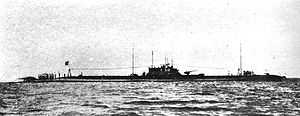Japanese submarine I-158
 | |
| Career | |
|---|---|
| Name: | I-158 |
| Builder: | Yokosuka Naval Arsenal |
| Laid down: | 3 December 1924, as I-58 |
| Launched: | 3 October 1925 |
| Completed: | 15 May 1928 |
| Renamed: | 20 May 1942, as I-158 |
| Fate: | Scuttled in 1946 |
| General characteristics [1] | |
| Class and type: | Kaidai-class submarine (Type IIIA) |
| Displacement: | 1,833 long tons (1,862 t) surfaced 2,602 long tons (2,644 t) submerged |
| Length: | 330 ft (100 m) |
| Beam: | 26 ft (7.9 m) |
| Draught: | 16 ft (4.9 m) |
| Propulsion: | 2 × diesel engines, 6,800 hp (5.1 MW) Electric motors, 1,800 hp (1.3 MW) |
| Speed: | 20 knots (37 km/h; 23 mph) (surfaced) 8 kn (15 km/h; 9.2 mph) (submerged) |
| Range: | 10,000 nmi (19,000 km) at 10 kn (19 km/h; 12 mph) (surfaced) |
| Test depth: | 60 m (200 ft) |
| Complement: | 60 officers and men |
| Armament: | 6 × 533 mm (21 in) forward torpedo tubes 2 × 533 mm (21 in) aft torpedo tubes 1 × 12 cm (4.7 in)/50 cal. deck gun |
'I-158 was a Kaidai-class submarine (KD3 Type) of the Imperial Japanese Navy during World War II
10 December 1941: 140 miles east of Kuantan, Malaya. Shortly after midnight, I-58 is running on the surface when her lookouts spot approaching British ships 656 yards (600 m) off the starboard bow. I-58 dives immediately. Kitamura attempts to fire a full six-torpedo salvo on the leading PRINCE OF WALES, but his first torpedo tube's outer door jams. P.O.W. passes by. REPULSE comes by next. Kitamura fires all his remaining torpedoes, but misses. He reports Force Z proceeding SSW at 24 knots. The report is received by light cruiser SENDAI that relays it to Vice Admiral Ozawa's flagship, cruiser CHOKAI. At 0615, I-58 loses contact with Force Z. That afternoon, Force Z is overwhelmed by torpedo-bombers of the 22nd Air Flotilla from bases in Indochina. Both British capital ships are sunk.
3 January 1942: NW of Bawean Island. At 0145, I-58 attacks Dutch merchant LANGKOEAS, she's hit in the engine room by a torpedo and sunk by gunfire at 05S, 112E. The surviving crew of about 90 men abandons ship. Some whaleboats make it safely to sea, but are machine-gunned by I-58. Three survivors are hauled aboard the submarine, interrogated by LtCdr Kitamura and then thrown back into the sea. They spend four or five days on a raft they find and wash ashore on Bawean Island. Later, a Dutch PBY "Catalina" flying boat picks them up and returns them to Surabaya.
5 January 1942: Early in the morning while running surfaced, I-58 is attacked by an unidentified submarine, but the torpedo just grazes her side.
9 January 1942: Java Sea. W of Bawean Island. That same day, I-58 first shells and then torpedoes and sinks Dutch merchant CAMPHUYS at 04-30S, 111-47E. American PAUL JONES (DD-230) rescues her survivors. 22 February 1942: Java Sea between Tjilatjap and Padang. I-58 first shells, and then torpedoes, and sinks Dutch passenger ship PIJNACKER HORDIJK. Her skipper is questioned briefly and then released.
25 February 1942: Java Sea south of the Sunda Strait. Dutch merchant BOEROE is en route to Perth, Australia. At 1015, I-58 surfaces and fires a few shells but she is forced to submerge by a passing Dutch destroyer escorting two oilers. At 1130, I-58 fires two torpedoes, both hit and the BOEROE goes down slowly. All of her 70-man crew escape.
28 February 1942: Java Sea. I-58 torpedoes and damages British oiler BRITISH JUDGE in the 10 miles S of the Sunda Strait.
20 May 1942: The I-58 is renumbered as I-158
10 July 1942: I-158 is reassigned to be a school ship at Kure Navy Base.
17 March 1945: I-158 is damaged in a B-29 raid on Kobe. She is repaired and returned to service.
.[2]
Fate
Decommissioned on 30 November 1945, sunk as a target off the Gotō Islands on 1 April 1946.
References
- ↑ "Type KD3". combinedfleet.com. 2012. Retrieved 1 March 2012.
- ↑ Hackett, Bob; Kingsepp, Sander (2012). "IJN Submarine I-158: Tabular Record of Movement". combinedfleet.com. Retrieved 1 March 2012.
| ||||||||||||||||||||||||||||||||||